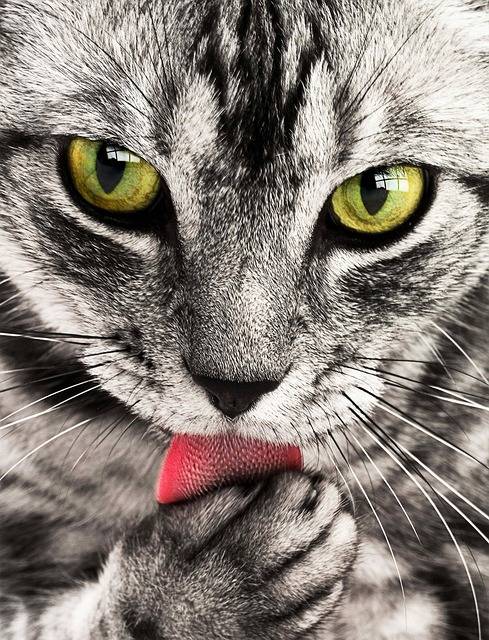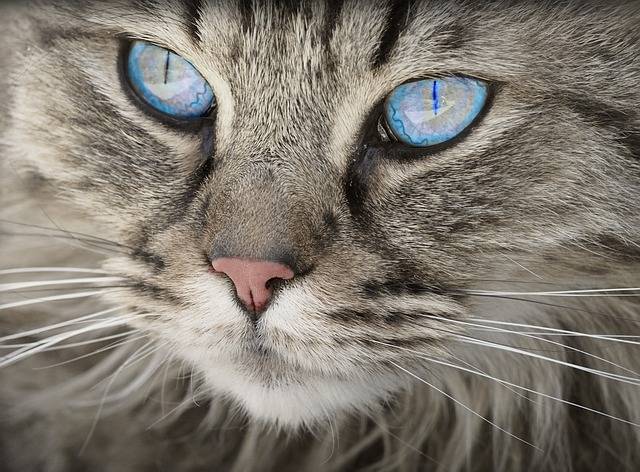cats
Deciphering Your Cat’s Body Language Signals

Deciphering Your Cat’s Body Language Signals
Decoding Your Cat’s Body Language: Understanding What Your Feline Friend is Saying
Have you ever wondered what your cat is trying to communicate to you? While it may initially seem like a mystery, deciphering your feline friend’s body language signals is actually quite simple. By paying close attention to their subtle cues, you can gain a deeper understanding of their emotions and needs.
From the twitch of their tail to the position of their ears, your cat is constantly sending you messages. By familiarizing yourself with their body language, you’ll be able to respond appropriately and strengthen your bond with your furry companion.
So, if you’re curious about what your cat is really thinking, get ready to unravel the secrets of their body language signals.
Key Takeaways
Understanding your cat’s body language signals is essential for building a strong bond and ensuring their happiness. By observing their tail twitches, ear positions, whisker alignment, eye dilation, and vocal clues, you can gain insight into their mood and emotions.
Cats have a unique way of communicating, and paying attention to these signals allows you to truly understand what they’re trying to convey. So, the next time your feline friend gives you a signal, respond accordingly to strengthen your connection.

Remember, cats are complex creatures with their own language, and decoding it will enhance your relationship with them.

Interpreting Tail Twitches and Swishes
Understanding Your Cat’s Tail Movements: Decoding Feline Body Language
To gain insight into your cat’s emotions and intentions, pay close attention to the subtle movements of their tail. The position and movement of their tail can communicate a wealth of information. By understanding these cues, you can better interpret your cat’s body language and strengthen your bond with your feline friend.
Tail Positions and Their Meanings
When your cat holds its tail straight up in the air, it’s a sign of confidence and happiness. A slightly curved tail signifies relaxation, while a puffed-up tail indicates fear or aggression. These tail positions can provide valuable clues about your cat’s emotional state.
Decoding Tail Swishes

In addition to tail positions, the way your cat swishes its tail can reveal important information. A quick flick of the tail may suggest annoyance or impatience, while a slow, deliberate swish could indicate excitement or anticipation. By observing these tail movements, you can better understand your cat’s current state of mind.
Responding to Your Cat’s Cues
By paying attention to your cat’s tail movements, you can gain valuable insights into their feelings and respond accordingly. If you notice signs of fear or aggression, it’s important to give your cat space and avoid any actions that may escalate the situation. On the other hand, if your cat is displaying signs of happiness and relaxation, you can engage in play or offer affection to further strengthen your bond.
Decoding Ear Positions and Movements
Understanding Your Cat’s Ear Positions and Movements
To truly comprehend your feline companion’s communication signals, it’s important to pay close attention to their ear positions and movements. Cats have a unique way of expressing themselves through their ears, and by decoding their positions, you can gain valuable insights into their thoughts and emotions.
Here are some key points to help you understand and interpret your cat’s ear language:
- Understanding ear flattening and twitching: When a cat’s ears flatten against their head, it usually indicates fear or aggression. On the other hand, twitching ears can signify excitement or curiosity.
- Decoding ear positions and their meaning: When your cat’s ears are facing forward, it indicates alertness and attentiveness. Sideways ears can indicate relaxation or contentment. Backward-facing ears, however, are a sign of fear or aggression.
- Pay attention to the direction and movement of your cat’s ears. Cats have the ability to rotate their ears independently, allowing them to focus on different sounds or stimuli.
- Remember that each cat is unique, and their ear positions and movements may vary. It’s important to observe your cat’s body language as a whole to get a complete understanding of their emotions.
Whisker Alignment and Mood Indicators
Understanding your cat’s mood and emotions can be as simple as observing their whisker alignment. When your cat’s whiskers are aligned forward, it indicates that they’re engaged and excited, especially during playtime. On the other hand, if their whiskers are pulled back, it could signal fear or anxiety. Paying attention to your cat’s whisker positioning is essential as it can also give you insights into their aggression levels. When a cat is about to attack or feels threatened, their whiskers may be flattened against their face. This correlation between whisker alignment and aggression can help you better understand your cat’s behavior and respond accordingly.

Now, let’s delve into another crucial aspect of your cat’s body language: their eyes. The dilation and focus of their eyes can provide further clues about their emotions.
The Eyes Have It: Dilation and Focus
Understanding your cat’s emotions can be a rewarding and fulfilling experience. One way to gain insight into their feelings is by observing their eyes. Let’s take a closer look at how your cat’s eyes communicate their emotions through dilation and focus.
- Pupil constriction: When your cat is relaxed and content, their pupils will become smaller. Conversely, if they feel threatened or anxious, their pupils may dilate and become larger.
- Gaze direction: Paying attention to where your cat is looking can reveal a lot about their emotions. Maintaining eye contact with you shows trust and a desire for interaction. On the other hand, if they avoid eye contact or intensely stare at something, they may be feeling defensive or focused on their surroundings.
- Blinking: Slow blinking is a sign of affection and relaxation in cats. When your cat blinks at you with half-closed eyes, it’s their way of expressing love and trust.
- Squinting: If your cat squints, it indicates that they feel comfortable and at ease in their environment. It’s a sign that they aren’t on high alert and are content.
By paying attention to these subtle cues in your cat’s eyes, you can deepen your bond and better understand their needs. Remember, each cat is unique, so take the time to observe and learn their individual communication style.
As you develop this understanding, you’ll create a stronger connection with your feline companion.
Vocal Clues: From Purrs to Growls
Understanding your cat’s vocalizations can provide valuable insights into their emotions and needs. Cats use different vocal cues, such as meowing and growling, to communicate. Meowing is a versatile form of communication with various meanings. A short, high-pitched meow may signify a greeting or a request for attention, while a long, low-pitched meow could indicate distress or dissatisfaction.
To fully understand your cat’s message, it’s important to consider the context and observe their body language. Similarly, different types of growls can reveal your cat’s emotions. A low, rumbling growl may indicate aggression or territoriality, while a high-pitched growl could suggest fear or pain.
Frequently Asked Questions
How Can I Tell if My Cat Is Feeling Relaxed or Stressed Based on Their Tail Movements?
Decoding your cat’s body language and understanding their emotional state can be done by observing their tail movements. When a cat is relaxed, you will notice a gentle swaying motion of their tail. On the other hand, a stressed cat may have an arched or puffed-up tail. By paying attention to these subtle cues, you can gain insights into how your feline friend is feeling.

What Does It Mean When My Cat’s Ears Are Flattened Against Their Head?
When your cat’s ears are flattened against their head, it indicates that they are feeling scared or aggressive. Understanding your cat’s body language is essential for interpreting their behavior and maintaining a harmonious relationship with your feline companion. By paying attention to these subtle cues, you can better respond to your cat’s needs and create a safe and comfortable environment for them.
How Can I Determine if My Cat Is Feeling Friendly or Aggressive Based on Their Whisker Alignment?
To determine if your cat is feeling friendly or aggressive based on their whisker alignment, simply observe their whiskers. If their whiskers are relaxed and pointing forward, it indicates a friendly demeanor. On the other hand, if their whiskers are pulled back tightly against their face, it suggests aggression. This aspect of cat behavior and body language is crucial for understanding their emotions and interactions with you and other animals. By paying attention to their whisker alignment, you can better communicate and respond to your feline companion’s needs.
What Are the Signs of Fear or Excitement That I Should Look for in My Cat’s Eyes?
When it comes to your cat’s eyes, you can tell if they are feeling fearful or excited by looking at their pupils. When a cat is afraid, their pupils will dilate, becoming larger than usual. On the other hand, if your cat is excited, their eyes may be wide open, showing a sense of alertness. Additionally, pay attention to their tail movements, as a relaxed and calm cat will have a still tail, while a stressed cat may have a twitching or lashing tail. By observing these cues, you can better understand your cat’s emotions and respond accordingly.
Can the Different Types of Vocalizations My Cat Makes Indicate Different Emotions or Needs?
Understanding the significance of different types of vocalizations in cats is important. By observing the body language cues that indicate a cat’s emotional state, you can determine if they’re expressing specific needs or emotions through their various vocalizations.
Conclusion
Understanding your cat’s body language signals is key to building a strong bond and ensuring their happiness. By observing their tail twitches, ear positions, whisker alignment, eye dilation, and vocal clues, you can gain insight into their mood and emotions.
Cats have a unique way of communicating, and by paying attention to these signals, you can truly understand what they’re trying to convey. So, next time your feline friend gives you a signal, respond accordingly to strengthen your connection.
Remember, cats are complex creatures with their own language, and decoding it will enhance your relationship with them.

table, th, td { border: 1px solid black; border-collapse: collapse; padding: 10px;}
cats
Little Kitten My Favorite Cat – Play Fun Pet Care Kids Game – Fun Games For Kids & Children

By: ArcadeGaming
Title: Little Kitten My Favorite Cat – Play Fun Pet Care Kids Game – Fun Games For Kids & Children
Sourced From: www.youtube.com/watch?v=Hyju6Gwo_gs
cats
Guy Thinks He’s Lost His Foster Cat | The Dodo

By: The Dodo
Title: Guy Thinks He”s Lost His Foster Cat | The Dodo
Sourced From: www.youtube.com/watch?v=Jn4YJr_pWzY
cats
How To Train Your Cat: Two Methods You Need To Know

By: Cat School Clicker Training
Title: How To Train Your Cat: Two Methods You Need To Know
Sourced From: www.youtube.com/watch?v=LJVQINS8xFk
-

 cats7 months ago
cats7 months agoHow to Get Your Cats to Stop… Everything You Hate: Every No Needs a Yes!
-

 All Animals1 year ago
All Animals1 year agoALL about Lagomorphs Explained!
-

 All Animals10 months ago
All Animals10 months agoExplore the Wilderness: ALL about Carnivores Unleashed!
-

 Animals1 year ago
Animals1 year agoThe Wonders: ALL About Artiodactyls
-

 Cat Breeds6 months ago
Cat Breeds6 months agoWhat Are Some Rare Domestic Cat Breeds?
-

 Cat Breeds6 months ago
Cat Breeds6 months agoWhat Are the Top Family-Friendly Domestic Cat Breeds?
-

 Cat Breeds6 months ago
Cat Breeds6 months agoDiscover Rare Domestic Cat Breeds With Our Guide
-

 Cat Breeds6 months ago
Cat Breeds6 months agoTop Family-Friendly Domestic Cat Breeds































